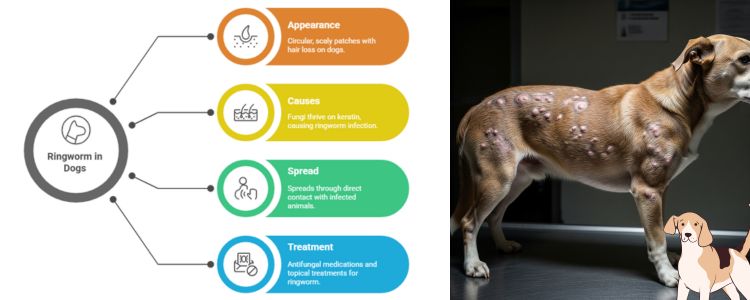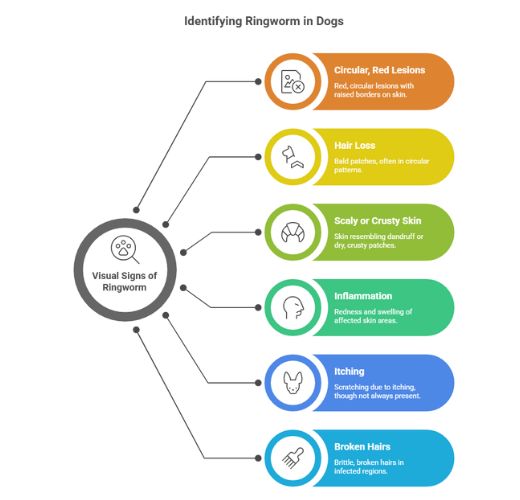Your furry friend means the world to you. Seeing them happy and healthy is every pet parent’s dream. But sometimes, unwelcome guests can appear. One common skin issue is ringworm. Knowing what does ringworm look like on a dog is crucial. Early detection helps your dog heal faster. It also protects other pets and even humans in your home.
Ringworm is not a worm at all. It is a fungal infection. Different types of fungi cause it. These fungi thrive on keratin. Keratin is found in skin, hair, and nails. Ringworm can affect many animals. Dogs are certainly no exception. This guide will help you identify ringworm. You will learn how it spreads. We will also discuss treatment options.
Unmasking the Culprit: What Exactly is Ringworm?
Ringworm gets its name from its appearance. It often forms a red, ring-shaped rash. This rash can be itchy. The center might be scaly or bald. But not always. The shape can vary. It might just look like a patch of flaky skin. This can make it tricky to identify.
The scientific name for ringworm is dermatophytosis. It is highly contagious. It spreads through direct contact. This means touching an infected animal. Or touching contaminated objects. Think about pet bedding. Or grooming tools. Even carpets can harbor the spores. These spores are tiny. They are very resilient. They can live for a long time.
The Tell-Tale Signs: What Does Ringworm Look Like on a Dog?
Recognizing ringworm early is vital. The typical presentation is a circular lesion. This lesion often has a red border. The center appears scaly. Hair loss is common. The affected area might be inflamed.
However, ringworm can show up differently. It might just be an area of patchy fur loss. There might be no redness. The skin might look dull. Some dogs develop widespread scaling. This can resemble dandruff. The skin might also appear crusty. Sometimes, small bumps appear. These bumps might ooze.
Common locations for ringworm include the face. Especially around the eyes and ears. Legs and paws are also common. These areas touch contaminated surfaces. The belly and flanks can also be affected. Lesions can spread. They can merge. This creates larger, irregular patches.
Some dogs show no symptoms. They are carriers. They can still spread the fungus. This makes prevention tricky. It highlights the importance of good hygiene.
Key visual signs to watch for:
- Circular, red lesions: Often with a raised border.
- Hair loss: Bald patches, sometimes in a circular pattern.
- Scaly or crusty skin: Resembling dandruff or dry skin.
- Inflammation: Redness and swelling of the skin.
- Broken hairs: Hairs in the affected area might appear brittle.
- Itching: Though not always present, some dogs will scratch.
Says Dr. Sarah Wooten, DVM, a veterinary expert.
“Ringworm can be very subtle in dogs, sometimes appearing as just a few broken hairs or a small area of dandruff,”
“Pet owners need to be vigilant for any changes in their dog’s coat or skin.”
Beyond the Rash: Other Symptoms and How Ringworm Affects Your Dog
While skin lesions are primary, other signs can appear. Dogs might scratch or lick affected areas. This can lead to secondary bacterial infections. These infections cause more redness. They can also cause pus. This complicates diagnosis and treatment.
Nails can also be affected. This is called onychomycosis. The nails become brittle. They might look discolored. They can become misshapen. This can be painful for your dog. They might avoid walking.
Puppies and older dogs are more susceptible. Their immune systems are weaker. Dogs with compromised immune systems are also at higher risk. This includes dogs on certain medications. Or dogs with underlying health conditions.
Consider the general health of your dog. Is their coat dull? Are they losing weight? These can be signs of other issues. But they can also make your dog more vulnerable.
How Does Ringworm Spread? Understanding the Transmission Cycle
Understanding transmission is key to prevention. Ringworm spreads in several ways.
- Direct Contact: This is the most common route. An infected dog touches another animal. Or a human. The fungal spores transfer.
- Indirect Contact: Spores can survive on surfaces. This includes bedding, toys, and grooming tools. Even human clothing. If your dog touches these items, they can become infected.
- Environment: Ringworm spores are tough. They can live in the environment for months. Contaminated soil is a source. Kennels and dog parks can harbor spores.
- Asymptomatic Carriers: Some dogs carry ringworm. They show no symptoms. But they can still spread the fungus. This is why vigilance is crucial.
According to a study published in the Journal of Feline Medicine and Surgery, dermatophyte spores can remain infectious in the environment for up to 18 months under ideal conditions. While this study focuses on cats, the longevity of spores in the environment is similar for dog-related infections.
Here’s a helpful video from a veterinarian explaining ringworm in dogs:
[Embed YouTube Video: (Search for “Dog Ringworm Explained by Vet” or similar, choose a reputable source like a vet clinic or educational channel. Example: a video from “Veterinary Secrets” or “Dr. Karen Becker”)]
Replace this with an actual embedded YouTube video. You would typically use the embed code provided by YouTube for a specific video.
Getting a Diagnosis: What Your Vet Will Do
If you suspect ringworm, see your vet. Do not try to self-diagnose. Many skin conditions look similar. Your vet can perform tests.
The most common test is a fungal culture. Your vet will take hair and skin samples. These samples are placed on a special culture medium. The fungus will grow. This can take several days. Sometimes up to two weeks.
Another tool is a Wood’s lamp. This is a special UV light. Some types of ringworm glow under it. Not all types, though. So a negative Wood’s lamp test does not rule out ringworm.
Microscopic examination is also used. Your vet might look at hair samples. They will search for fungal spores. This offers a quicker preliminary diagnosis. But a culture is definitive.
Accurate diagnosis ensures proper treatment. This is important for your dog’s health. It also protects your family.
Treatment Options: Helping Your Dog Recover
Treating ringworm requires patience. It often involves multiple approaches.

- Topical Medications: Shampoos, creams, and ointments are common. These are applied directly to the skin. They help kill the fungus. They also prevent spread. Your vet might recommend a medicated shampoo. This often contains miconazole or ketoconazole.
- Oral Medications: For severe or widespread cases, oral antifungals are needed. These medications work systemically. They kill the fungus from the inside out. Examples include griseofulvin or itraconazole. These drugs require careful monitoring. Your vet will check liver function.
- Environmental Decontamination: This is crucial. Spores live everywhere. You must clean thoroughly. Vacuum frequently. Wash all bedding. Disinfect hard surfaces. Use a diluted bleach solution (1:10 bleach to water). Or a fungicidal spray.
“Environmental decontamination is as important as treating the pet,” states the Cornell Feline Health Center
Treatment can last weeks. Sometimes months. Do not stop treatment early. Even if symptoms improve. The fungus can return. Your vet will recommend follow-up cultures. This ensures the infection is gone.
Preventing Ringworm: Keeping Your Dog Safe
Prevention is always better than cure. Here are steps to minimize risk.
- Hygiene: Keep your dog clean. Regular grooming helps.
- Avoid Contact: Limit contact with unknown animals. Especially those with skin issues.
- Clean Environment: Regularly clean your home. Focus on pet areas. Wash bedding weekly.
- Isolate New Pets: Quarantine new animals. Observe them for symptoms.
- Boost Immunity: Provide good nutrition. Ensure proper veterinary care. A strong immune system fights infection.
- Prompt Action: If you suspect ringworm, act fast. Early treatment limits spread.
Remember, ringworm is zoonotic. This means it can spread to humans. Children, the elderly, and immunocompromised individuals are most at risk. Practice good hand hygiene. Wear gloves when handling infected pets. Clean your hands thoroughly.
When to Worry: Complications and Long-Term Outlook
Most cases of ringworm resolve with treatment. But complications can occur. Secondary bacterial infections are common. These might need antibiotics. Deep infections are rare. They can be harder to treat.
For healthy dogs, the long-term outlook is good. The hair usually grows back. The skin heals completely. For dogs with underlying health issues, recovery might be slower. The infection might recur.
Persistent or recurring ringworm warrants further investigation. Your vet might look for underlying immune problems. Or other health conditions.
The Human Connection: Ringworm in People
Yes, people can get ringworm from dogs. It usually appears as an itchy, red, circular rash. The edges are often raised. The center might be clear. This is why it’s called “ringworm.” It is the same fungus.
If you develop a rash, see your doctor. Tell them about your dog’s condition. Treatment for humans is usually topical. Antifungal creams work well.
Preventing human infection is simple. Wash hands after touching your pet. Avoid direct contact with infected areas. Clean shared spaces diligently. This is especially important during treatment.
Final Thoughts: Be Vigilant, Be Proactive
Knowing what does ringworm look like on a dog empowers you. You can spot the signs early. Early detection means faster treatment. It minimizes suffering for your dog. It also protects your household.
Do not panic if your dog gets ringworm. It is treatable. It requires dedication. Follow your vet’s instructions carefully. Complete the full course of treatment. Implement environmental cleaning. Your diligence will pay off. Your dog will be back to their happy, healthy self.
Keep an eye on your dog’s skin and coat. Regular grooming helps you notice changes. A healthy dog is a happy dog. And a happy dog makes for a happy home.
Frequently Asked Questions (FAQs)
Q1: Is ringworm always itchy for dogs?
A1: No, not always. Some dogs experience significant itching. Others show very little or no itching. The presence or absence of itching does not confirm or rule out ringworm.
Q2: Can my dog get ringworm from my cat?
A2: Yes, absolutely. Ringworm is highly contagious among animals. It can spread between different species, including dogs, cats, and even humans. It is important to treat all infected pets in the household.
Q3: How long does it take for ringworm to clear up in dogs?
A3: Treatment duration varies. It usually takes several weeks. Sometimes it can take months. Your vet will recommend continuing treatment until two consecutive negative fungal cultures. This ensures the infection is completely gone.
Q4: Can I use over-the-counter creams for my dog’s ringworm?
A4: You should always consult your veterinarian first. While some human antifungal creams might be similar, the dosage and type of medication might not be suitable for dogs. Also, your vet will confirm the diagnosis. This ensures you are treating the correct condition.
Q5: Is it possible for my dog to get ringworm multiple times?
A5: Yes, it is possible. Having ringworm once does not provide lifelong immunity. Your dog can become reinfected if exposed to the fungus again. This highlights the importance of environmental cleaning and preventing future exposure.


